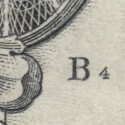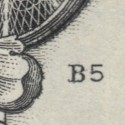 32-subject note |
 50-subject note |
In late 2012, the BEP's Fort Worth, TX facility began to overprint serial numbers and seals on some $1 notes on the new LEPE (Large Examining and Printing Equipment), rather than the COPE (Currency Overprinting and Processing Equipment) system that had been in use for the previous several decades. The Washington, DC facility began to overprint $1 notes on LEPE in early 2014.
 32-subject note |
 50-subject note |
COPE works with sheets of 32 notes; LEPE can handle either the 32-subject sheets or the new, larger 50-subject sheets. Notes printed in 50-subject sheets can be identified by the style of the plate position indicator on each note: the letter and number are now the same size, instead of the large letter and small number used on 32-subject notes.
All notes from 50-subject sheets are overprinted on LEPE. But 32-subject sheets continue to be overprinted on both COPE and LEPE. Serials and seals printed by LEPE look substantially identical to those printed by COPE, but the LEPE notes are nevertheless identifiable: Since LEPE operates quite differently than COPE, the relationship between serial numbers and plate positions is radically changed. In order to determine whether a given 32-subject note was printed on COPE or LEPE, use the following calculations:
For COPE:
|
For LEPE:
|
Notice, however, that occasionally a note will happen to have the same plate position under both numbering systems. In that case, other notes from the same run must be examined to determine how that particular run was overprinted.
In a new BEP bundle of 1,000 notes with COPE overprinting, all 1,000 notes will come from the same plate position (unless there are COPE swaps as mentioned above). But in a bundle of 1,000 notes with LEPE overprinting, the plate position will change for each successive 100-note strap.
One interesting observation about the LEPE-overprinted runs: It appears that in these runs, the notes with serial numbers ending in 9999 or 0000 are no longer replaced by star notes, but are actually issued.
The BEP's monthly production reports do not indicate which serial number ranges were printed on COPE and which on LEPE, so the information below has been compiled from collector observations.
LEPE was first used in October 2012, during the production of the Series 2009 $1. For the following two years, 2009 $1 notes were serialled on both LEPE and COPE, all in 32-subject sheets. Reports from collectors have now allowed every 2009 $1 print run to be classified as either COPE or LEPE, so the tentative breakdown that formerly appeared here has been finalised and moved to the 2009 $1 page proper.
All Series 2013 and later $1's have been printed in 50-subject sheets, so all have been serialled on LEPE.
In the $2 denomination, both COPE and LEPE overprinting of 32-subject sheets have been used in Series 2013 and 2017A. Reports from collectors have now allowed every 2013 $2 print run to be classified as either COPE or LEPE, so the tentative breakdown that formerly appeared here has been finalised and moved to the 2013 $2 page proper.
| COPE | LEPE | undetermined |
For the 2017A $2's, however, identifying which print runs were produced in which manner is still an ongoing project. If you have any 2017A $2 notes from serial ranges that are still listed as undetermined, please report them to me at webmaster@uspapermoney.info (include the serial number, plate position, and face and back plate numbers). Many thanks for your assistance!
| Month | Federal Reserve District (First letter of serial number) | Star Notes | Month | |||||||||||||||||
|---|---|---|---|---|---|---|---|---|---|---|---|---|---|---|---|---|---|---|---|---|
| A | B | C | D | E | F | G | H | I | J | K | L | |||||||||
| Aug 19 | A 000 00001 A A 064 00000 A |
|
- | - | - | - |
|
- | - | - |
|
- | C 000 00001 * C 009 60000 * |
Aug 19 | ||||||
| Sep 19 | - | B 128 00001 A B 256 00000 A |
C 000 00001 A C 064 00000 A |
D 000 00001 A D 064 00000 A |
E 000 00001 A E 128 00000 A |
- | - | H 000 00001 A H 064 00000 A |
I 000 00001 A I 064 00000 A |
J 000 00001 A J 064 00000 A |
- | - | C 032 00001 * C 0?? ????? * |
Sep 19 | ||||||
Beginning with the first Series 2017A $5 printings in June 2019, the $5 denomination was converted to 50-subject printing, and therefore also to LEPE serialling.
No 32-subject $5 notes have been observed with LEPE plate positions. However, through a FOIA request to the BEP it has been discovered that the three runs of 2013 $5 MK..* notes printed at Fort Worth in early 2014 were LEPE products. None of these star notes entered circulation at the time, as Fort Worth was not then printing any regular $5's. Now that $5 production has returned to Fort Worth, it will be interesting to see whether any of these stars are now used.
No notes in denominations above $5 have been observed with LEPE plate positions. It seems unlikely that any additional denominations will be converted to LEPE overprinting until the BEP acquires more LEPE lines at some time in the future; most overprinting is still done by COPE at this time.